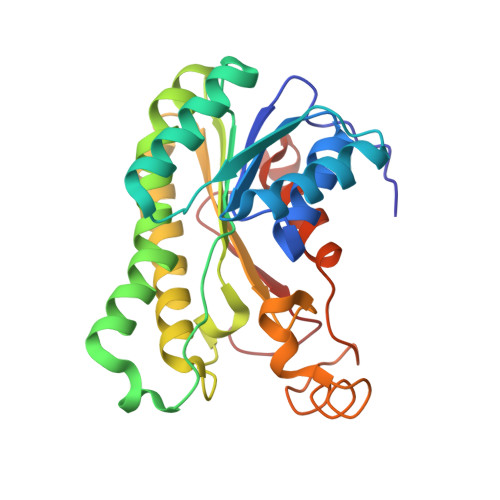Crystal structure and catalytic characterization of the dehydrogenase/reductase SDR family member 4 (DHRS4) from Caenorhabditis elegans.
Kisiela, M., Faust, A., Ebert, B., Maser, E., Scheidig, A.J.(2018) FEBS J 285: 275-293
- PubMed: 29151266
- DOI: https://doi.org/10.1111/febs.14337
- Primary Citation of Related Structures:
5OJG, 5OJI - PubMed Abstract:
The human dehydrogenase/reductase SDR family member 4 (DHRS4) is a tetrameric protein that is involved in the metabolism of several aromatic carbonyl compounds, steroids, and bile acids. The only invertebrate DHRS4 that has been characterized to date is that from the model organism Caenorhabditis elegans. We have previously cloned and initially characterized this protein that was recently annotated as DHRS4_CAEEL in the UniProtKB database. Crystallization and X-ray diffraction studies of the full-length DHRS4_CAEEL protein in complex with diacetyl revealed its tetrameric structure and showed that two subunits are connected via an intermolecular disulfide bridge that is formed by N-terminal cysteine residues (Cys5) of each protein chain, which increases the enzymatic activity. A more detailed biochemical and catalytic characterization shows that DHRS4_CAEEL shares some properties with human DHRS4 such as relatively low substrate affinities with aliphatic α-diketones and a preference for aromatic dicarbonyls such as isatin, with a 30-fold lower Km value compared with the human enzyme. Moreover, DHRS4_CAEEL is active with aliphatic aldehydes (e.g. hexanal), while human DHRS4 is not. Dehydrogenase activity with alcohols was only observed with aromatic alcohols. Protein thermal shift assay revealed a stabilizing effect of phosphate buffer that was accompanied by an increase in catalytic activity of more than two-fold. The study of DHRS4 homologs in simple lineages such as C. elegans may contribute to our understanding of the original function of this protein that has been shaped by evolutionary processes in the course of the development from invertebrates to higher mammalian species. Structural data are available in the PDB under the accession numbers 5OJG and 5OJI.
Organizational Affiliation:
Institute of Toxicology and Pharmacology for Natural Scientists, University Medical School Schleswig-Holstein, Kiel, Germany.
















